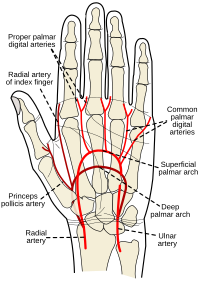
Photo from wikipedia
Radial artery occlusion (RAO) is a well known complication that occurs after traditional radial artery (TRA) intervention and limits the radial artery as a future access site, as well as… Click to show full abstract
Radial artery occlusion (RAO) is a well known complication that occurs after traditional radial artery (TRA) intervention and limits the radial artery as a future access site, as well as an arterial conduit. Distal radial artery (DRA) access has emerged recently as an alternative approach with a potential lower incidence of RAO. Database search of Pubmed/MEDLINE, Cochrane Library, and EMBASE was conducted by two authors from inception through 1 October 2022. Randomized trials that compared TRA with the DRA approach to perform coronary angiography were included. Two authors extracted pertinent data into predefined data collection tables. The risk ratios and 95% confidence intervals (CIs) were reported. Eleven trials were included (5700 patients) in the study. The mean age was 62.0 ± 10.9 years. Compared with DRA, vascular access through the TRA was associated with a higher incidence of RAO (risk ratio 3.05, 95% CI, 1.74–5.35, P < 0.01); however, arterial access by using the TRA was associated with a lower incidence of access failure leading to a crossover compared with the DRA approach (risk ratio 0.35; 95% CI, 0.21–0.57, P < 0.01). The incidence of radial artery spasm and access site-associated hematoma was not significant in the group treated with TRA compared with the DRA approach (P > 0.05). The DRA approach was associated with a lower incidence of RAO compared with the TRA approach but this was at the expense of a higher crossover rate.
Journal Title: Coronary Artery Disease
Year Published: 2023
Link to full text (if available)
Share on Social Media: Sign Up to like & get
recommendations!